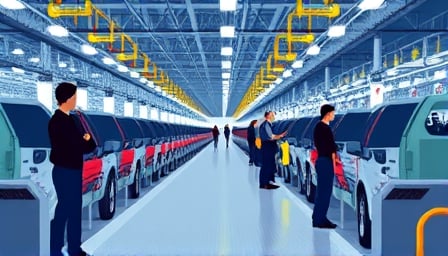Stellantis NV Stumbles Through a Crisis of Ambition and Accountability
Stellantis NV, long heralded as the benchmark for global automotive manufacturing, is confronting a confluence of strategic missteps and regulatory headaches that threaten to erode its standing in an increasingly competitive market. The company’s recent abandonment of a 2030 all‑electric vehicle (EV) target, coupled with a massive recall of Jeep Grand Cherokee plug‑in hybrids and an ongoing investigation over Chrysler minivan steering, paints a stark picture of a firm grappling with its own ambition.
The Unattainable Promise
The CEO’s appeal to the European Union for “more flexible rules” for EVs and a relaxation of CO₂ reduction deadlines is a bitter pill to swallow. By declaring the 2030 all‑electric goal “unachievable,” Stellantis has exposed the inadequacy of its internal forecasting and supply‑chain planning. In a sector where electrification is no longer a trend but a survival imperative, such a public reversal undermines investor confidence and invites scrutiny from regulators who are already tightening emissions mandates.
Recall Fallout: A Costly Liability
Nearly 92,000 Jeep Grand Cherokee plug‑in hybrids are now subject to a recall in the United States due to a software defect that can cause sudden loss of propulsion. This is more than a technical glitch; it is a reputational calamity that could translate into billions in compensation and a prolonged erosion of brand trust. The defect also raises serious safety concerns, potentially exposing the company to lawsuits and a barrage of negative media coverage that could further depress its stock price.
Steering Issues in Chrysler Minivans
Adding insult to injury, US authorities are investigating steering problems in the company’s Chrysler minivan line. While the investigation’s outcome remains uncertain, the mere fact of regulatory scrutiny signals deeper systemic issues in design, testing, or quality assurance—areas that have long been the Achilles heel of Stellantis.
A Silver Lining: The Tofaş Production Contract
Amid these turbulence, Stellantis has inked a production agreement with Turkey’s Tofaş to develop a new light commercial vehicle (LCV), backed by an investment of up to €256 million. This contract could bolster the company’s production capacity and enhance its competitiveness, particularly in emerging markets. However, the benefits of this deal are likely to be marginal when weighed against the ongoing recall and regulatory investigations, which continue to dominate the narrative.
Market Impact and Shareholder Sentiment
Despite these setbacks, the company’s stock price has displayed a surprising degree of resilience, showing only marginal volatility over the past year. This stability can be attributed to several factors: the market’s short‑term focus on macroeconomic trends, the sheer size of Stellantis’s global operations, and the defensive nature of the automotive sector. Nonetheless, the long‑term implications of abandoning the EV roadmap and dealing with widespread recalls could prove more detrimental than immediate price movements suggest.
The Road Ahead
Stellantis’s trajectory hinges on its ability to reconcile short‑term operational challenges with a coherent, forward‑looking strategy. The company must:
- Reassert Credibility – Deliver transparent, data‑driven evidence that its revised electrification timeline is realistic and aligned with market demands.
- Strengthen Quality Assurance – Overhaul the software development lifecycle to prevent future recalls and restore consumer confidence.
- Leverage New Partnerships – Utilize the Tofaş contract as a platform to accelerate LCV production without compromising quality.
- Engage Regulators Proactively – Negotiate realistic timelines for compliance while demonstrating commitment to environmental goals.
In a market where agility and accountability are paramount, Stellantis’s failure to adapt swiftly could transform its recent strategic missteps from temporary hiccups into a long‑term liability. Only time will reveal whether the company can turn this precarious moment into a catalyst for robust, sustainable growth.
